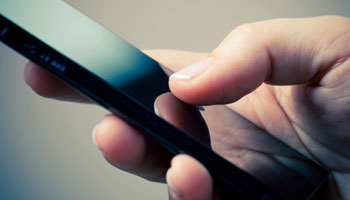08.01.2015
That Smartphone Is Giving Your Thumbs Superpowers
When people spend time interacting with their smartphones via touchscreen, it actually changes the way their thumbs and brains work together, according to a report in the Cell Press journal Current Biology on January 5th 2015 (Gindrat, Chytiris, Balerna, Rouiller and Ghosh) on a study conducted in collaboration at University of Fribourg (Prof. E.M. Rouiller and collaborators) and at University of Zürich and ETHZ (Dr. A. Ghosh). More touchscreen use in the recent past translates directly into greater brain activity when the thumbs and other fingertips are touched, the study shows.

“I was really surprised by the scale of the changes introduced by the use of smartphones,” said Arko Ghosh. “I was also struck by how much of the inter-individual variations in the fingertip associated brain signals could be simply explained by evaluating the smartphone logs.”
It all started when Ghosh and his colleagues realized that our newfound obsession with multitasking phones could be a grand opportunity to explore the everyday plasticity of the human brain. Not only are people suddenly using their fingertips, and especially their thumbs, in a new way, many of us are doing it an awful lot, all the time, day after day. Not only that, but our phones are keeping track of our digital histories to provide a readymade source of data on those behaviors.
Ghosh and colleagues explain it this way: “We must first appreciate how common personal digital devices are and how densely people use them. What this means for us neuroscientists is that the digital history we carry in our pockets has an enormous amount of information on how we use our fingertips (and more).”
While neuroscientists have long studied brain plasticity in expert groups – musicians or video gamers, for instance - smartphones present an opportunity to understand how regular life shapes the brains of regular people.
To link digital footprints to brain activity in the new study, the authors used electroencephalography (EEG) to record the brain response to mechanical touch stimuli delivered on the thumb, index, and middle fingertips of touchscreen phone users in comparison to people who haven’t given up their old-school mobile phones.
The researchers found that the neural activity in the brain (somatosensory cortex) was enhanced in smartphone users for all three fingertips. In fact, the amount of activity in the cerebral cortex associated with the thumb and index fingertips were directly proportional to the intensity of phone use as quantified by built-in battery logs. The thumb tip was even sensitive to day-to-day fluctuations in phone use: the shorter the time elapsed from an episode of intense phone use, the researchers report, the larger was the cortical potential associated with it.
The results suggest to the researchers that repetitive movements over the smooth touchscreen surface reshape sensory processing from the hand, with daily updates in the brain’s representation of the fingertips depending upon phone use.
And that leads to a pretty remarkable idea: “We propose that cortical sensory processing in the contemporary brain is continuously shaped by personal digital technology,” Ghosh and his colleagues write.
What exactly this influence of digital technology on sensory processing means for us in other areas of our lives is a question for another day. The news might not be so good, Ghosh and colleagues say, noting evidence linking excessive phone use with motor dysfunctions and pain.
Link to the article:
www.ncbi.nlm.nih.gov/pubmed/24428642
Contact:
Prof. Eric Rouiller, Department of Medicine, 026 300 86 09, eric.rouiller@unifr.ch
Anne-Dominique Gindrat, Department of Medicine, 026 300 86 12, anne-dominique.gindrat@unifr.ch
